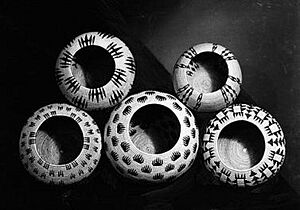Dat So La Lee facts for kids
Quick facts for kids
Louisa Keyser,
Dat So La Lee |
|
|---|---|
 |
|
| Born |
Dabuda
1829 near Schurz, Nevada
|
| Died | December 6, 1925 |
| Nationality | Washoe |
| Education | Self-taught |
| Known for | Basket weaving |
Louisa Keyser, also known as Dat So La Lee (born around 1829 – died December 6, 1925), was a very famous Native American basket weaver. She was part of the Washoe people from Nevada. Her amazing baskets became well-known across the country in the early 1900s.
Many museums today still show her beautiful baskets. You can see them at places like the Penn Museum in Philadelphia. They are also at the Smithsonian National Museum of the American Indian in Washington, D.C.. Other museums include the Nevada State Museum and the Metropolitan Museum of Art in New York.
Contents
What Does Dat So La Lee Mean?
Dat So La Lee was not her birth name. It was a special name she used for her art. People have different ideas about where this name came from.
One idea is that "Dat So La Lee" means "Big Hips" in the Washoe language. Another idea is that she got the name from someone she worked for. Her art dealers, the Cohns, said her birth name was Dabuda, which means "Young Willow."
How Her Art Became Famous
Dat So La Lee met her art dealers, Amy and Abram Cohn, around 1895. She was likely working for them as a laundress. The Cohns quickly saw how special her basket weaving was. They wanted to sell Native American art, so they decided to help her become famous. Abram "Abe" Cohn owned a men's clothing store in Carson City, Nevada.
The Cohns started keeping records of every basket she made from 1895 to 1925. They documented about 120 baskets in total. Most of these baskets were sold at Cohn's store. In return, the Cohns gave Louisa Keyser food, a place to live, and healthcare.
Her baskets were very valuable because of her amazing skill. The Cohns' early records also helped make her artwork well-known. Later, experts found that some things the Cohns wrote about her were not completely true.
In 1945, the state of Nevada bought 20 of Dat So La Lee's baskets. Ten went to the Nevada Historical Society in Reno, Nevada. The other ten went to the Nevada State Museum in Carson City. The records about the baskets came with them. Some baskets were stolen in 1979 but were all found by 1999.
Her Special Weaving Style
Dat So La Lee mostly used willow branches to make her baskets. She would start with three willow rods. Then, she would weave other willow strands around them.
Her most common style was called degikup. These baskets had a flat bottom. They would get wider in the middle and then narrow down to a small hole at the top. This degikup style became very popular among other Washoe basket weavers.
Where She Rests
Dat So La Lee is buried in the Stewart Cemetery in Carson City, Nevada. Even though her work was known by many different cultures, she only wanted a Woodfords medicine man named Tom Walker to help her. He prepared her for death.
On December 2, 1925, they began a four-day ritual. This helped her prepare to pass away. She died on December 6, 1925. Her simple grave marker says: "Dat So La Lee / Famous Washoe Basket Maker / Died 12. 6. 25."
The Dat So La Lee Post #12 of the American Legion in Reno is named after her.
See also
 In Spanish: Dat So La Lee para niños
In Spanish: Dat So La Lee para niños
- Dat So La Lee House, Carson City
- Native American basket weavers
- Sarah Jim Mayo


